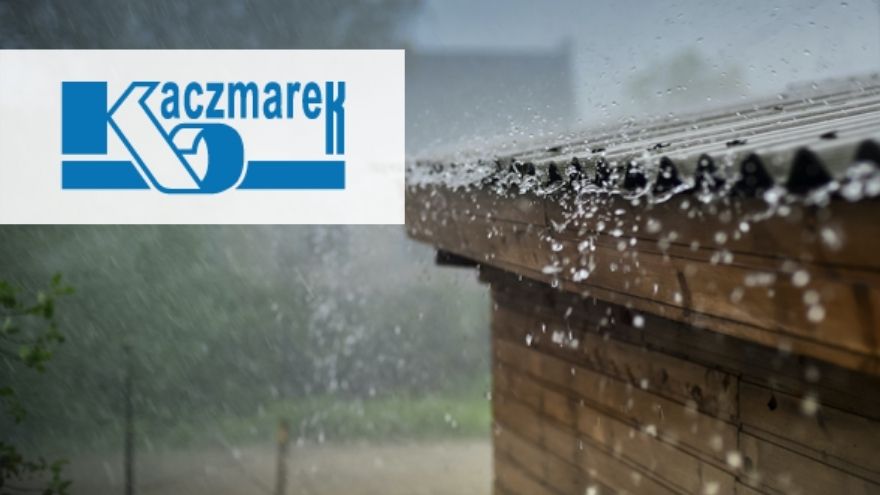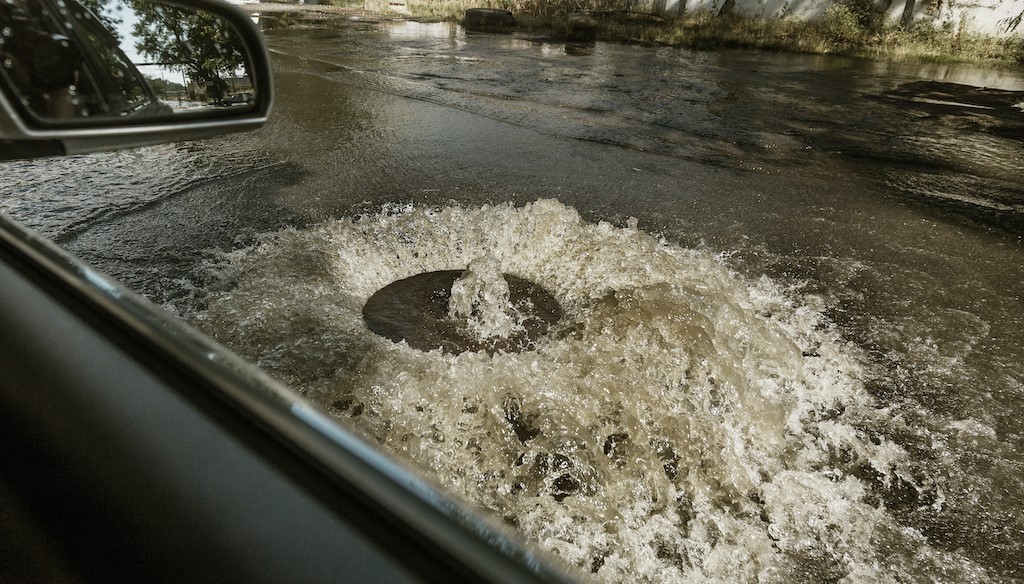As a result of ongoing climate change, the number of rainy days in Poland is increasing. We also experience extreme rainfall more often. This poses challenges for us in terms of rainwater drainage - especially in cities with a high share of impervious surfaces. Rainwater tanks may be the solution to these problems. Read our guide and find out which rainwater tank to choose.

From the article you will learn:
- what are urbanized catchments,
- drain rainwater as quickly as possible,
- what are the functions of the retention tank,
- how to choose the right capacity of a rainwater tank.
Rainwater drainage - contemporary challenges in cities
In modern cities, the areas occupied by the so-called urbanized catchments are increasing. These are spaces where the share of impervious surfaces is greater than 5%. They include, among others, streets, sidewalks, parking lots, squares and building roofs. The scarcity of green areas in such places results in a reduction of their natural retention capacity. Rainwater, which previously could seep into the ground, now must be discharged into the sewage system.
Check out the Kaczmarek brand offer now!
Rainwater should be drained as quickly as possible due to disruptions to car and pedestrian traffic. Remaining rainfall also has a destructive impact on buildings and street surfaces. Unfortunately, cities are facing major problems due to the regular increase in rainfall. More and more often, there are situations in which the sewage system is not able to drain all the rainwater.

It doesn't help that the old canals were designed with lower stormwater runoff rates in mind. New sewage networks are also unable to carry away all rainwater in the event of extreme rainfall. For technical and economic reasons, cables with smaller diameters are selected. All this leads to local floods . They are particularly troublesome in urbanized areas, characterized by high population density and concentration of numerous buildings. In such a case, excess rainwater may paralyze the city.
Retention tanks as a solution to the problem of excess rainwater
Rainwater tanks may be a solution to the problem of draining rainwater from urban areas. They are used both in the modernization of existing sewage systems and in the design of new investments. What do they give?
- The rainwater tank stores excess rainwater and gradually discharges it to the network or to receivers.
- Its main task is to relieve the sewage system and protect water against excessive pollution.
- The rainwater container allows you to connect a new catchment area to the existing network without the need to expand it.
- The rainwater tank can also be used as an object averaging the sewage inflow to the treatment plant.
- Above-ground tanks are also used to store rainwater on the plot for later use or to gradually discharge it into the storm sewage system.
Hydro-Box system – rainwater tank
An example of an efficient rainwater tank is the Hydro-Box system by Kaczmarek. Its base is a box with dimensions of 0.8 x 0.8 x 0.8 meters and a capacity of 476 liters. It is made of polypropylene and can be combined with other identical elements . Thanks to this, you can easily adjust the size and shape of the rainwater container to your individual needs and the nature of your property.
Check out rainwater tanks at the Onninen wholesaler
Depending on whether you surround the connected boxes with geotextile or impermeable foil, you will receive either a water infiltration system or a water storage tank . The Hydro-Box system is therefore versatile in its use, but this is not its only advantage. Others include:
- perfect tightness,
- complete resistance to corrosion,
- resistance to ultraviolet radiation,
- light weight,
- easy and quick assembly,
- wide range of chemical resistance,
- can also be used in difficult ground and water conditions,
- possibility of use in the road and under squares.
Hydro-Box rainwater tank - where is it used?
The Hydro-Box rainwater tank is used in both single-family and multi-family buildings . This system is used in industrial areas, in pedestrian and car transport routes, as well as in public facilities. You will encounter it in schools, playgrounds, service and commercial buildings and office buildings.
Check out the Kaczmarek brand offer!
Hydro-Box rainwater tanks are used to manage rainwater from roofs, driveways, parking lots and streets. Due to the fact that the Kaczmarek system also includes a number of additional elements, it can be used to build an efficiently functioning drainage or retention system .
The Hydro-Box rainwater container can also be used for storing drinking, technical or fire-fighting water, sanitary sewage, industrial sewage or liquid chemicals.
Why is it worth using rainwater tanks on your property?
Discharging rainwater into the sewage system often involves paying an appropriate tax. Moreover, if the land user does not have access to appropriate watercourses, he must manage the water on his own . This is where a rainwater tank comes in handy. It will help to properly collect rainwater and then manage it.

Underground tanks will not take up valuable space on your property, and will help you manage problematic rainwater. You can either gradually soak it into the ground or put it to good use. You can use rainwater to water the garden , wash cars or flush the toilet. This will not only get rid of excess rainwater, but you will also save on your water bills .
How to choose the size of a rainwater tank?
To select the appropriate size of the rainwater tank, the selected calculation method should be used. They are divided into detailed and simplified methods.
Before choosing a method for calculating the appropriate capacity of a water tank, it is necessary to distinguish between garden, home and home-garden systems. Each of them has a different system for calculating the size of the retention container.
In each of the three systems, it is important to take into account the minimum roof area in the simplified calculations. Additionally, in a garden system, the area of land to be irrigated is also important, while in a home system - the number of inhabitants. However, in the garden-house system, both the garden area and the number of residents living in the building are taken into account. On this basis, you should use ready-made tables provided by manufacturers to select the appropriate capacity of the rainwater tank.
What is the detailed method for calculating the size of the retention reservoir? In this case, several parameters are taken into account. The first is the horizontal projection of the building's roof surface. It is important to take into account only those parts of the roof from which rainwater will actually flow into the container.
In this method, the second parameter is the runoff coefficient, which indicates the actual amount of rainwater that can flow into the container. It is determined based on the type of roofing and the angle of the roof.
The third parameter taken into account is the location of the building from which rainwater is to be drained. It is determined on the basis of maps presenting data on the average annual rainfall.
Multiplying these three parameters together gives the result of the annual water yield from the installation.
Do you have questions about the industry? Join the Świat Instalacji group!
How to choose a rainwater tank?
When choosing a rainwater tank for your home, pay attention primarily to its intended purpose.
Above-ground rainwater tanks
If you want easy access to it, take a look at above ground tanks . This type of product simply needs to be placed under the gutter to store excess water. You can use it for cleaning around the house and in the garden and for many other purposes. Just remember to opt for an opaque above-ground tank, as otherwise the water will heat up, which encourages algae growth.
Underground tank for rainwater
If you don't have space for an above-ground tank, choose an underground tank . In this case, you don't have to worry about heating rainwater. What's more, access to it will not be difficult at all - just invest in an appropriate pump or other system that supplies water to the places you choose. The size of the rainwater tank depends on both your needs and the space available on your property. Remember that by choosing the Hydro-Box system, you can conveniently combine individual elements to create a container that exactly meets your requirements.
Check out the Kaczmarek brand offer and install the perfect rainwater tank on your property. Thanks to it, you will eliminate excess rainwater and put it to good use!